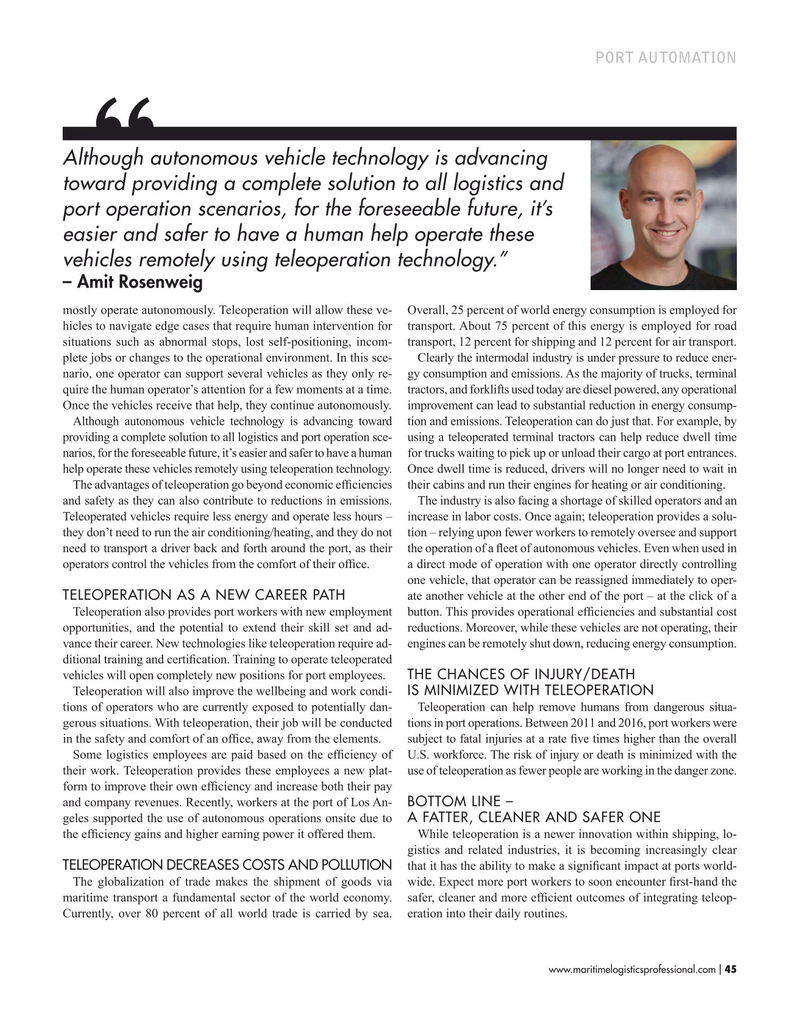
Page 45: of Maritime Logistics Professional Magazine (Nov/Dec 2019)
Short Sea Shipping Ports
Read this page in Pdf, Flash or Html5 edition of Nov/Dec 2019 Maritime Logistics Professional Magazine
PORT AUTOMATION
Although autonomous vehicle technology is advancing toward providing a complete solution to all logistics and port operation scenarios, for the foreseeable future, it’s easier and safer to have a human help operate these vehicles remotely using teleoperation technology.” – Amit Rosenweig mostly operate autonomously. Teleoperation will allow these ve- Overall, 25 percent of world energy consumption is employed for hicles to navigate edge cases that require human intervention for transport. About 75 percent of this energy is employed for road situations such as abnormal stops, lost self-positioning, incom- transport, 12 percent for shipping and 12 percent for air transport. plete jobs or changes to the operational environment. In this sce- Clearly the intermodal industry is under pressure to reduce ener- nario, one operator can support several vehicles as they only re- gy consumption and emissions. As the majority of trucks, terminal quire the human operator’s attention for a few moments at a time. tractors, and forklifts used today are diesel powered, any operational
Once the vehicles receive that help, they continue autonomously. improvement can lead to substantial reduction in energy consump-
Although autonomous vehicle technology is advancing toward tion and emissions. Teleoperation can do just that. For example, by providing a complete solution to all logistics and port operation sce- using a teleoperated terminal tractors can help reduce dwell time narios, for the foreseeable future, it’s easier and safer to have a human for trucks waiting to pick up or unload their cargo at port entrances. help operate these vehicles remotely using teleoperation technology. Once dwell time is reduced, drivers will no longer need to wait in
The advantages of teleoperation go beyond economic effciencies their cabins and run their engines for heating or air conditioning.
and safety as they can also contribute to reductions in emissions. The industry is also facing a shortage of skilled operators and an
Teleoperated vehicles require less energy and operate less hours – increase in labor costs. Once again; teleoperation provides a solu- they don’t need to run the air conditioning/heating, and they do not tion – relying upon fewer workers to remotely oversee and support need to transport a driver back and forth around the port, as their the operation of a feet of autonomous vehicles. Even when used in operators control the vehicles from the comfort of their offce. a direct mode of operation with one operator directly controlling one vehicle, that operator can be reassigned immediately to oper-
TELEOPERATION AS A NEW CAREER PATH ate another vehicle at the other end of the port – at the click of a
Teleoperation also provides port workers with new employment button. This provides operational effciencies and substantial cost opportunities, and the potential to extend their skill set and ad- reductions. Moreover, while these vehicles are not operating, their vance their career. New technologies like teleoperation require ad- engines can be remotely shut down, reducing energy consumption.
ditional training and certifcation. Training to operate teleoperated vehicles will open completely new positions for port employees. THE CHANCES OF INJURY/DEATH
IS MINIMIZED WITH TELEOPERATION
Teleoperation will also improve the wellbeing and work condi- tions of operators who are currently exposed to potentially dan- Teleoperation can help remove humans from dangerous situa- gerous situations. With teleoperation, their job will be conducted tions in port operations. Between 2011 and 2016, port workers were in the safety and comfort of an offce, away from the elements. subject to fatal injuries at a rate fve times higher than the overall
Some logistics employees are paid based on the effciency of U.S. workforce. The risk of injury or death is minimized with the their work. Teleoperation provides these employees a new plat- use of teleoperation as fewer people are working in the danger zone.
form to improve their own effciency and increase both their pay and company revenues. Recently, workers at the port of Los An-
BOTTOM LINE –
A FATTER, CLEANER AND SAFER ONE geles supported the use of autonomous operations onsite due to the effciency gains and higher earning power it offered them. While teleoperation is a newer innovation within shipping, lo- gistics and related industries, it is becoming increasingly clear
TELEOPERATION DECREASES COSTS AND POLLUTION that it has the ability to make a signifcant impact at ports world-
The globalization of trade makes the shipment of goods via wide. Expect more port workers to soon encounter frst-hand the maritime transport a fundamental sector of the world economy. safer, cleaner and more effcient outcomes of integrating teleop-
Currently, over 80 percent of all world trade is carried by sea. eration into their daily routines.
www.maritimelogisticsprofessional.com 45
I

 44
44

 46
46
